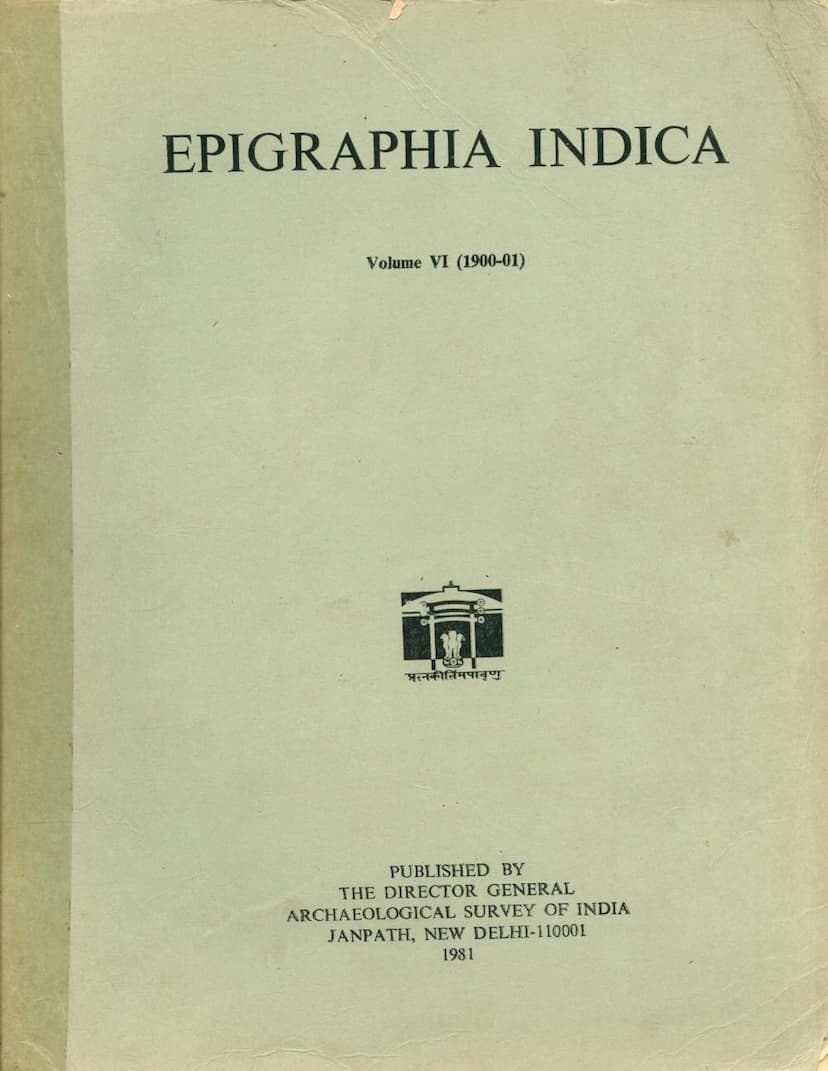Epigraphia Indica Vol 06
Added to library: September 1, 2025

Summary
This volume, "Epigraphia Indica Vol. 06," published by the Archaeological Survey of India and edited by E. Hultzsch, is a collection of inscriptions from the period 1900-1901. The primary focus of this volume is to present and analyze epigraphic records from various regions of India, detailing historical events, dynasties, rulers, and administrative practices.
A significant portion of the volume is dedicated to inscriptions related to the Jain tradition, as indicated by the catalog link and internal references. While the provided text focuses on detailed transcriptions and translations of inscriptions from various dynasties and time periods, the underlying purpose is to contribute to the understanding of India's historical and cultural past, which includes the study of Jainism.
Here's a summary of the key types of content and themes found in the volume, based on the provided text:
1. Dynastic Histories and Royal Genealogies:
- The volume extensively covers inscriptions detailing the histories of prominent Indian dynasties, including:
- Western Chalukyas: The Aihole inscription of Pulakesin II (Saka-Samvat 556) is a significant piece, detailing the reign, military exploits, and court poet Ravikirti.
- Rashtrakutas: Several inscriptions, including the Radhanpur plates of Govinda III (Saka-Samvat 730) and the Nilgund inscription of Amoghavarsha I (A.D. 866), are analyzed, providing insights into their genealogy, administration, and religious patronage. The complex relationships and evolving appellations of Rashtrakuta kings are a particular focus.
- Western Gangas of Talakad: Three records from the Mysore Government Museum are re-edited, shedding light on rulers like Nitimarga, Satyavákya, Ereyappa, and Bûtuga II, and clarifying their chronology and historical context.
- Chola Kings: Several inscriptions with Saka dates are analyzed to refine the understanding of the commencement of reigns for kings like Rajaraja, Rajendra-Chola I, Rajadhiraja, and Rajendradeva, correcting previous interpretations.
- Kadambas: Two Kadamba grants, the Kodgere plates of Vijaya-Siva-Mandhatrivarman and the Bannahalli plates of Krishṇavarman II, are presented, detailing land grants and discussing the likely relationships between rulers like Mrigêsavarman and Mandhatrivarman.
- Eastern Chalukyas: The Mayidavolu plates of Sivaskandavarman are discussed, noting their Prakrit language, archaic alphabet, and the expansion of the Pallava kingdom into the Telugu country.
- Vijayanagara Empire: Inscriptions related to Krishṇaraya, specifically the Gadag inscription and the Kondavidu pillar inscription, are analyzed, detailing administrative appointments, military campaigns, and the acts of ministers like Sålva-Timmå.
- Orissan Dynasties: Inscriptions from Bhuvanesvar are analyzed, discussing rulers like Sasankaraja and Eastern Ganga kings, and noting the specific characteristics of the Eastern Indian alphabet and the use of numerical symbols in dates.
2. Religious and Philosophical Content:
- Several inscriptions mention Jaina tradition: The Aihole inscription of Pulakesin II. celebrates the founding of a temple for Jinêndra. The Konnur inscription of Amoghavarsha I. records grants for a Jaina sanctuary founded by Bankeya and mentions the sage Devendra from the Pustaka gachchha of the Desiya gana of the Mûla sangha. The Manne grant, though spurious, also mentions the Jaina teacher Simhanandin.
- Vaishnavism and Shaivism are also represented, with invocations to Vishnu (Hari, Narayana) and Siva (Mahesvara, Trikutesvara) in various inscriptions. The influence of religious traditions on the interpretation of historical and cultural practices is a recurring theme.
3. Linguistic and Paleographic Analysis:
- The volume showcases the expertise of its contributors in analyzing the language (Sanskrit, Prakrit, Kannada, Telugu, Tamil) and scripts (various stages of Southern and Northern Indian alphabets, including Grantha) of the inscriptions.
- Detailed discussions on the evolution of scripts, the significance of individual letter forms, and the correct reading of archaic or damaged texts are provided, contributing to the field of Indian paleography.
4. Historical and Chronological Refinements:
- The inscriptions provide crucial data for establishing and refining the chronologies of various dynasties. The editor and contributors meticulously analyze dates, regnal years, and Jovian years to correlate them with historical events and establish accurate timelines for rulers.
- Discrepancies in dates and names from earlier studies are identified and corrected, highlighting the rigorous methodology of epigraphic research.
5. Additions and Corrections:
- The volume includes sections for "Additions and Corrections" for both Volume V and VI, demonstrating a commitment to scholarly accuracy and the ongoing nature of historical research. These sections address earlier misinterpretations, offer alternative readings, and update existing knowledge based on new findings or further analysis.
In essence, "Epigraphia Indica Vol. 06" is a foundational work for the study of ancient Indian history and epigraphy. It meticulously presents primary source material in the form of inscriptions, providing detailed scholarly analysis that illuminates the political, religious, and cultural landscape of India, with significant contributions to the understanding of Jainism through its epigraphic evidence.
It's important to note that while the catalog link mentions "JAIN EDUCATION INTERNATIONAL," the content of the volume itself is a scholarly publication of the Archaeological Survey of India. The Jain connection arises from the specific inscriptions analyzed within the volume that pertain to Jain patrons, temples, or religious figures.